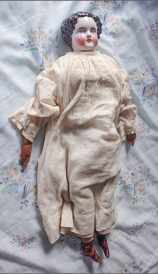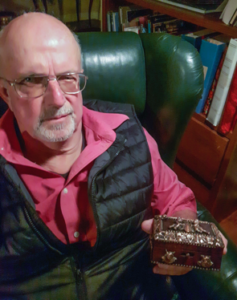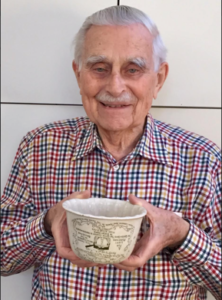RTHS “Bring & Brag”
This year marked RTHS’s first (and hopefully last!) Zoom AGM, and 22 participants logged in from the comfort of their homes to be welcomed by President Susan McKellar, and to be brought up-to-date of our Society’s activities during the past unprecedented year segment, when members can show off a unique and remarkable item from their household goods.
Bring and Brag The AGM formalities having been concluded, the best part of the evening could begin, namely the annual “Bring and Brag” Often an item has deep personal meaning, such as the charming antique doll that Susan McKellar presented. The beautifully preserved toy named Isabelle, with its china head and cloth body, belonged to her beloved Grandma Lettie. Some of its clothing may have been original, particularly its leather gloves and boots. Years of children’s play has taken a bit of a toll, and Susan has had to perform a few repairs with needle and thread, but Isabelle is still prepared to become the loving companion of someone in Susan’s extended family.

Some items are a bit more of a mystery. Sandy McNiece displayed a small carved wooden box, ornamented with a rather odd combination of cherubs and Viking heads. It dates back to the early 1800s, he believes, and comes from England. It could very well be a small tea caddy, as tea was a much dearer commodity back in those days. Or, Sandy speculated, might it have been a container for a more stimulating product – opium? Hard to say, but it is an unusual ornament, no matter what its origin!

Owen Cooke held up an example of a 25-cent bank note issued by the Canadian Bank Note Company in July 1923. The production of this particular type of paper money, nicknamed a shinplaster, dates back to the 1880s, when there was a shortage of circulating metal coinage; people hoarded and melted coins down when the intrinsic value of the of metal rose above the value of the coin itself. The value of a shinplaster today? Depending upon its condition, it could fetch between $5.00 and $100.00! Maybe it’s time to cash it in, Owen!

Dennis Osmond produced a rare item from wife Anne’s grandmother’s kitchen back in England – a fluted glazed earthenware blancmange/jelly mold made by Grimwades Potteries of England. What particularly distinguishes this piece of cookware is the advertising imprinted on its side, which promotes the Patent Quick Cooker which claims to cook stews of all kinds in half the time. What’s even more remarkable is the endorsement of the product by Queen Mary, who apparently claimed that it was indispensable in every home. However, it is unclear whether it was used in Buckingham Palace itself.

The carbide mining lamp with wick that Bill Tupper brought forward made us all realize how grim and hazardous the life of a miner was back in the early 1900s. It replaced more primitive lamps that initially burned candles, and then lamps with wicks and filled with whale oil or, eventually, kerosene, and it produced a bright white light that could last for up to five hours. While it was considered a breakthrough in its time, there was still the danger of coming in contact with open flames. Altogether, not a desirable work environment.
Ruth Mills is a retired milliner and, not surprisingly, enjoys collecting historic hats. But the ladies watching this Zoom presentation were really left wondering if the style of hat which Ruth displayed would have been a fashion statement they would have cared to make! The “calash” bonnet was a triumph of function over glamour, designed to shelter in place the oversized, elaborate hairdos of the mid-to-late 1700s. Stiffened material was stretched over hoops made of whale bone, or bamboo canes, with ribbons to control the raising and lowering of this millinery dome; it operated upon the same principle as the collapsible tops of carriages of the same name. Small wonder that, however practical it was for the wearer, this fashion was lampooned by the media of the time. Later on, the brim of this hat was expanded forward to shade the delicate complexion of its wearer; not surprisingly, this version was dubbed “The Ugly” … and that it was!
2020 marked the 90 th anniversary of the Manotick Horticultural Society and former President Margot Belanger showed off the original minutes’ ledger of the Society. Begun at the first planning meeting in 1930, its hand-written contents take you through the history of this very active organization which has never ceased to take as much pride in its service to the community of Manotick as it does in the gardens of its membership.
Our last Bring and Bragger was Mary Armstrong, and she shared a very personal memento, a cloth badge of approximately 3”x4” bearing the words “Maple Leaf Forever”, which her dear father, Albert Edward Armstrong, carried in his pocket into the battlefield throughout World War One, together with his Bible. Mr. Armstrong served with the Princess Patricia’s Canadian Light Infantry and, happily, came safely home to his family in North Gower at war’s end. This year’s “Bring and Brag” held up the tradition of inspiring RTHS members to hunt through their treasures and come up with some amazing items!
